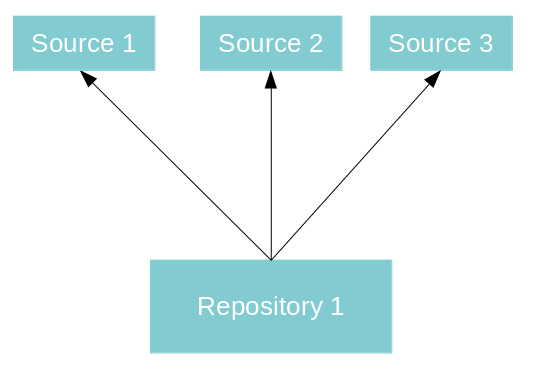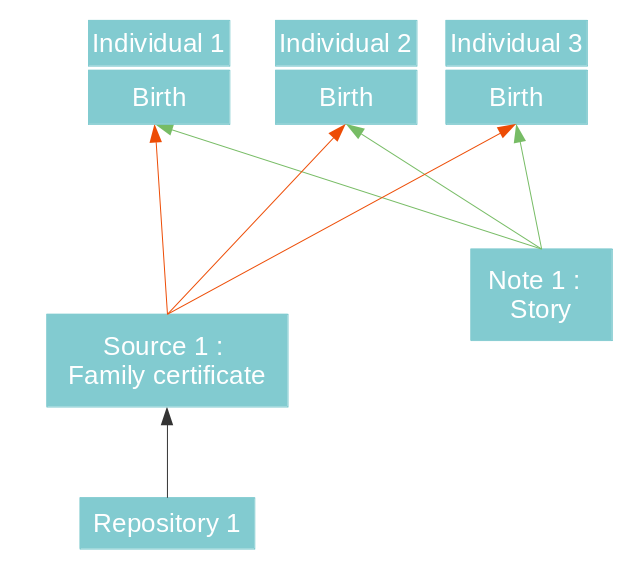Shared Information
TheSome pieces of information containedcollated in a genealogy iscan either be specific to an individual, or shared by several individuals or several families.families of that genealogy.
A genealogy contains a lot of information, you will necessarily want to be able to reuse most of it.
If you want to reuse information, we strongly recommend that you initially store it in an entity rather than in a property.
This is the case for all Notes, all Sources, all Repositories, and all Multimedia Elements.
These Entities are defined here in the dedicated Entities or Locations page..
Other information in Ancestris can be reused in a transparent way for you: these are places, occupations, types of events, diplomas, etc., and more generally all the short labels which describe events.
Principle
The principle, before creating any information in Ancestris, is to ask yourself whether this information is likely to be used again or not for other individuals.
Creation of shared information
If the information is likely to be reused:
- first create it as a new entity as such
- then link it from the other entity that will use it
In certain cases, the choice of shared information is obvious, such as repositories for instance.
In other cases, this choice is more subtle, such as PlacesSources and Notes.Notes.
Entities using shared information
Another benefit of using shared entities is when you want to know all the entities in your genealogy that use a given information. You can know so by selecting the shared entityentity. and theThe list of entities that use it appears in a list attached to this shared entity.
Conversely, it is a way to know if a shared entity is still being used at all.
Examples
Case of repositories
During your genealogical research, you will propablyprobably gathercollect several documents originating from the same location.
To store all this information, you will create this location as a single repository, indicating its description, address, contact details, etc.
Then all the extracted documents will be your sources. Each of these sources will indicate the same repository.
This repository can also be a regional archive, a town hall, a website, a cemetarycemetery for instance.
Example of three sources from the same repositoryrepository:
Case of a family record bookcertificate
If you discover a family bookletcertificate in which are indicated 3 children, and that in addition you write a note explaining your research,research story, you will have a diagram which could look like this:
The 3 individuals represent the siblings. Their births are sourced from the family record book,certificate, which itself is sourced from a repository.
And your note comes in to support your research or obserrvationsobservations about the 3 births.
You will notice in the diagram above that the source relates to the birth events of individuals, and not the individuals directly, which is more precise.
I assumed in the example that your note only spoke about the births of individuals. If it talkstalked about their lives more broadly, you should probably link your note to the individuals rather than just to their birth.
Case of a note
On the other hand, a note which comments on specifiesspecific circumstances relating only to aone single individual in particular should preferably be entered as an individual note and not generate the creation of a dedicated Note entity.
This is the case, for example, for details of a birth (the height and weight of the child, the fact that the person was born at his parents' home, etc.). These details will only ever relate to the birth of the individual in questionconsidered and it is more efficient to enter this information directly at the birth level as an individual note.
Case of a place
The first time a place is created, it appears in the event where it is used first. Ancestris does not allow you to put it in a Place entity, even if you think you might need to reuse it later. This is because the Gedcom standard did not define places as entities.
This is not a problem, Ancestris manages the repository of places for you and considers that each place can be reused.
However, you must be careful when you create a place: it is up to you to check if it does not already exist, in order to avoid creating a duplicate. A duplicate on a place is not annoying as such, but it becomes so when, for example, you correct one of the two while thinking of correcting them all.
To avoid generating a duplicate when entering a place, Ancestris automatically suggests all the places found in your genealogy that include the text being entered.
Also, thanks to the List of places view, it is possible to merge places that have been entered twice by mistake.
Steps
Creation
The creation of Notes, Sources, Repositories, and Multimedia Elements is done either via the ContextualContext Menu of Ancestris, or via the menu bar,bar, or automatically from the Cygnus editor or manually from the Aries editor.editor.
The creation of places is done by entering a place directly in the editors, or in the Places editor.editor.
Link
The link to an existing Note, Source, Repository, or Multimedia Elements is done via the ContextualContext Menu of Ancestris or via the Editors.
The link to an existing place is done as when it was created: when entering a place directly in the editors, or in the Places editor.editor.
Usage
To find out the list of entities using a particular Note, Source, Repository or Multimedia Element, all you have to do is select it from the table of entities for example, and view it in the Gedcom Editor.Editor.
You will then see all the entities using this information as a linked property.properties.
Here is foran example theof source S5 that we have selected in the table of entities.entities. If we look at the Gedcom Editor,Editor, we see the following imagefollowing:
This source S5 is used by four other entities / properties of the genealogy: the note N2 on the assassination by Ravaillac, the name of the individual I29 Robert Capet, the death of Louis IX, and the name of Marguerite de Provence.
In the case of a Place, the easiest way to find out in which events it is used, is to go to the List of Places list and select it. Events are listed by expanding the locationflap in the list. See the correspondingList sectionof Places for more details.
B-A BA
There is an educational B-A-BA on shared information in PDF format. It is written in French.
It corresponds to version 9 of Ancestris but most of it is still relevant.
It tells you in detail how to create and use each of the shared entities presented above.
You can download it here.



